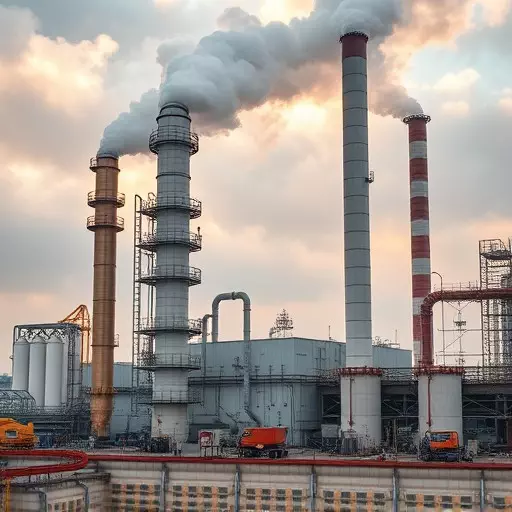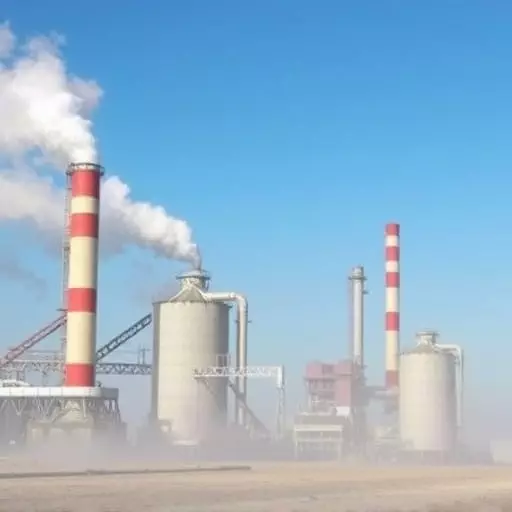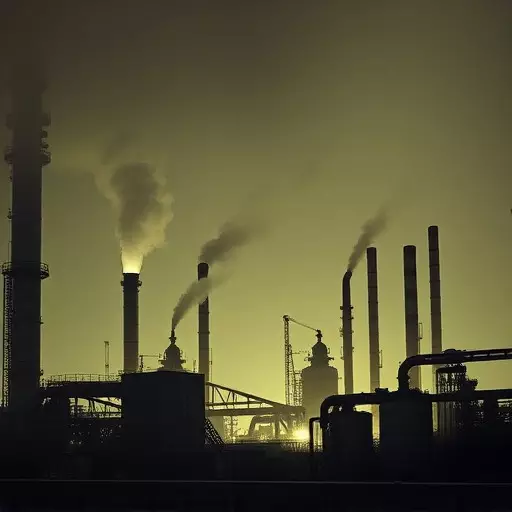Industrial air quality management faces significant challenges from diverse pollution sources, particularly dust generation from material handling and equipment operation. Advanced dust collection technologies like high-efficiency filters, baghouse systems, and real-time monitoring sensors are crucial for mitigating pollution and ensuring cleaner air. Emerging emission control measures, such as scrubbers, absorbers, and intelligent automation, further enhance air quality outcomes for industrial sites, meeting environmental regulations and fostering sustainability. Tailored solutions for specific industries, including mining, construction, chemical plants, and steel manufacturing, ensure healthier working environments and minimize environmental impact. Real-time monitoring and data analytics drive continuous improvement in air quality management, paving the way for a greener future.
The air we breathe on industrial sites is a critical concern. With growing awareness of environmental impact, finding effective air quality solutions for industrial sites has never been more pressing. This article explores the evolving landscape of dust collection solutions and emission control technologies, delving into the challenges posed by industrial activities and their environmental consequences. From traditional methods to cutting-edge innovations like advanced filtration and data analytics, we uncover strategies to achieve cleaner air and foster sustainable practices in industrial settings.
- Understanding the Industrial Air Quality Challenge: Sources and Impact
- Traditional Dust Collection Methods and Their Limitations
- Emerging Technologies for Effective Dust Control
- Advanced Emission Control Systems: Capturing Pollutants at the Source
- The Role of Filtration in Achieving Clean Air Goals
- Smart Sensors and Data Analytics: Monitoring and Optimizing Industrial Air Quality
- Sustainable Solutions: Green Initiatives in Industrial Air Management
Understanding the Industrial Air Quality Challenge: Sources and Impact

Industrial air quality management is a complex challenge due to various sources of pollution and their significant impact on both human health and the environment. Industrial sites, with their diverse operations, contribute to air pollution through several means. One primary source is dust generation from processes like material handling, construction activities, and equipment operation. These dusty emissions not only affect nearby communities but also pose risks to workers’ health.
Additionally, industrial facilities often release harmful gases and particulate matter as byproducts of manufacturing processes. Emission control technologies play a crucial role in mitigating these issues. Advanced dust collection solutions, such as high-efficiency filters and baghouse systems, are employed to capture and contain dusty particles. Furthermore, innovative emission control measures include scrubbers, absorbers, and advanced monitoring systems that reduce the release of pollutants into the atmosphere, ensuring cleaner air for both local communities and the broader environment.
Traditional Dust Collection Methods and Their Limitations

Traditional dust collection methods have long been a cornerstone of industrial air quality management, but they come with limitations that can hinder their effectiveness. These methods often rely on open-system designs that capture and contain dust particles using mechanical filters or baghouses. While they’ve served industries well for decades, they struggle to keep pace with modern production demands and environmental regulations.
One significant shortcoming is their inability to fully capture ultra-fine particulate matter, which poses the greatest health risks. Additionally, these traditional systems can be energy-intensive and require frequent filter replacement, leading to increased operational costs. They also tend to disrupt productivity due to downtime for maintenance and cleaning. To address these challenges, industries are increasingly adopting advanced emission control technologies and dust collection solutions tailored for modern industrial sites, aiming for better air quality outcomes.
Emerging Technologies for Effective Dust Control

Emerging Technologies for Effective Dust Control are transforming how industrial sites manage their air quality. Innovations in dust collection solutions have moved beyond traditional methods, incorporating advanced filtration systems and smart automation to significantly reduce emissions. These technologies not only capture fine particulate matter but also ensure efficient disposal or recycling of collected dust.
One notable trend is the integration of real-time monitoring sensors that detect dust levels and trigger automated cleaning processes. Additionally, new materials and designs in bag filters and cyclones enhance efficiency and minimize maintenance needs. With these advancements, industrial facilities can achieve better air quality solutions for their sites, contributing to healthier working environments and reduced environmental impact.
Advanced Emission Control Systems: Capturing Pollutants at the Source

Advanced Emission Control Systems play a pivotal role in revolutionizing air quality solutions for industrial sites. These cutting-edge technologies are designed to capture pollutants at their source, significantly reducing emissions and minimizing environmental impact. By employing innovative dust collection solutions, such as high-efficiency filters and advanced scrubbers, industrial facilities can effectively manage particulate matter and gaseous pollutants.
The implementation of emission control technologies not only enhances air quality but also contributes to a healthier work environment for employees and surrounding communities. With stricter regulatory standards in place, adopting these advanced systems has become imperative for industries aiming to stay compliant and sustainable. This shift towards more efficient emission control underscores the ongoing commitment to mitigate environmental risks and foster a greener future.
The Role of Filtration in Achieving Clean Air Goals

Industrial sites often face significant challenges in maintaining clean air due to various emissions and dust generated during manufacturing processes. To achieve air quality goals, implementing effective filtration systems is crucial. These systems act as a first line of defense against pollutants, capturing and containing harmful particles before they are released into the atmosphere. Advanced filtration technologies, including high-efficiency particulate air (HEPA) filters and bag filters, play a pivotal role in this regard. HEPA filters, for instance, can trap at least 99.97% of airborne particles as small as 0.3 microns, ensuring minimal release of dust and other contaminants into the surrounding environment.
The choice of filtration system depends on the specific industrial process and its associated emissions. Dust collection solutions tailored to capture fine particulate matter are essential for industries like mining and construction. Similarly, emission control technologies designed for gas and fume capture are vital in chemical plants and steel manufacturing. By combining efficient filtration with other air quality solutions, industrial sites can significantly reduce their environmental impact while adhering to stringent regulatory standards, contributing to a healthier atmosphere for both workers and communities surrounding these facilities.
Smart Sensors and Data Analytics: Monitoring and Optimizing Industrial Air Quality

Industrial air quality management has witnessed a significant transformation with the integration of smart sensors and data analytics. These cutting-edge technologies offer real-time monitoring capabilities, enabling manufacturers to gain deep insights into their site’s air quality. By strategically placing sensors, companies can accurately measure various pollutants, including particulate matter, gases, and volatile organic compounds (VOCs). This data is then analyzed to identify trends, pinpoint sources of pollution, and optimize emission control technologies.
The utilization of smart sensors and analytics provides a proactive approach to managing dust collection solutions. By continuously assessing air quality, manufacturers can quickly respond to any anomalies or spikes in emissions. This not only enhances overall environmental compliance but also contributes to the development of more efficient and targeted air quality solutions for industrial sites. As these technologies continue to evolve, they are poised to play an increasingly vital role in revolutionizing industrial practices and fostering a cleaner, healthier environment.
Sustainable Solutions: Green Initiatives in Industrial Air Management

Industrial air quality management is undergoing a sustainable transformation as companies embrace green initiatives to address environmental challenges. These innovative approaches focus on minimizing the ecological footprint while maintaining efficient operations. One key strategy involves implementing advanced dust collection solutions tailored for industrial sites, ensuring that airborne particulates are effectively captured and contained before they can cause pollution or health issues.
By integrating these technologies with emission control strategies, businesses can significantly reduce their impact on air quality. From filtration systems to scrubbers and other state-of-the-art tools, these sustainable solutions not only comply with environmental regulations but also contribute to a cleaner, healthier environment for both workers and nearby communities.
